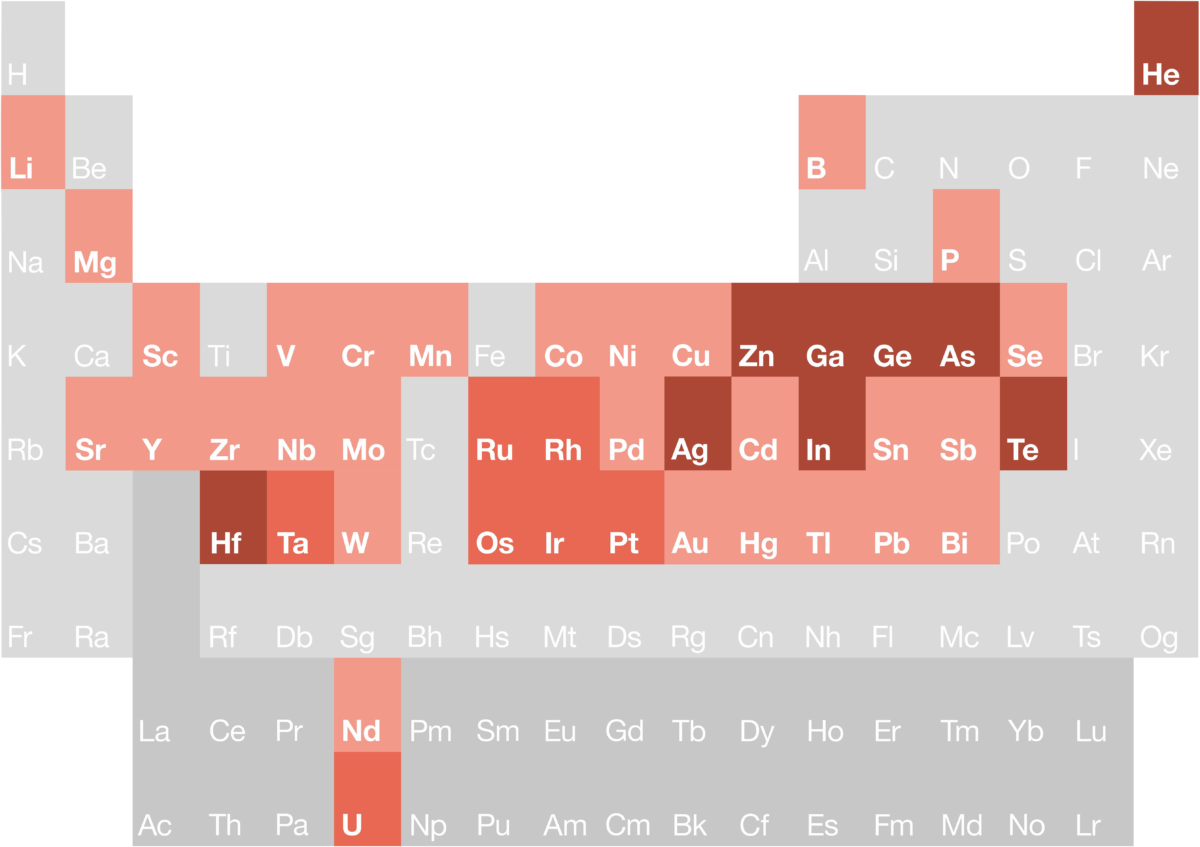Check this out
This project is also available in a printable broadsheet format.
View ➔
44 out of the 118 elements on the periodic table are facing supply shortages, and this problem is getting worse.
Original content by Andy Brunning/Compound Interest, American Chemical Society, Royal Society of Chemistry, and Chemical Sciences and Society Summit (CS3)
Edited by Boyang Zhang
People often assume that the elements, as the primary units that make up everything, are recoverable. However, they often face the same threats as natural resources. Of the 118 elements that make up everything — from the compounds in a chemist’s arsenal to consumer products on the shelf — 44 will face supply limitations in the coming years. What is even worse is that some of the elements are essential to human life, like phosphorus. Other rare earth elements and precious metals on the list are also extremely useful for their catalytic properties in fields such as pharmaceuticals and energy.
Reduce,
Reuse,
Recycle.
82% of UK households have no plans to recycle old electronic devices.
52% of teenagers have ten or more electronic devices in their home.
82%
52%
This is a global issue, and solving it will require everyone to take responsibility, including scientists, government, manufacturers, retailers, and you. Chemistry and chemical scientists have a key role to play in finding solutions, both in finding alternatives to these rare elements where possible, and in finding new, more effective ways to extract elements from used devices and recycle them. As consumers, we can all help by simply following the 3Rs of recycling: Reduce (extend the life of your phone by upgrading less often), Reuse (pass your old electronics to other, sell it or donate to a charity), Recycle (responsibly discard electronic waste rather than storing them).
Because elements are de facto a strictly limited resource, it is important to focus on recovery and recycling. It is crucial that these critical resources be used with consideration of the entire utilization cycle, from mining, to manufacturing, to recovery, and to reuse.
The Periodic Table’s Endangered Elements


We’re all familiar with Dimitri Mendeleev’s periodic table of chemical elements. It organizes all discovered chemical elements in rows (called groups) and columns (called periods) according to increasing atomic number. Scientists use the periodic table to quickly refer to information about an element, like atomic mass and chemical symbol. The periodic table’s arrangement also allows scientists to discern trends in element properties, including electronegativity, ionization energy, and atomic radius.
However, the majority of non-chemists probably aren’t familiar with the everyday uses of some of the many elements it contains. Some elements that many haven’t heard of find uses in technologies or applications we take for granted – but the supplies of these elements on Earth are not infinite. Today’s graphic, in a collaboration with the American Chemical Society’s Green Chemistry Institute, looks at some of the endangered elements in the periodic table, and why we might miss them when they’re gone.
In total, the graphic shows 44 elements whose supply is at risk. For some, the risk is more serious than for others – but there are nine elements shown in this table for which there is concern that there is a serious threat to their supply within the next 100 years, and a further seven for which there is a rising threat due to increased use. Here, we’ll take a look at some of these at-risk elements: their uses, why their supply is under threat, and what can be done to tackle this problem.
Mobile devices, for example, contain conflict elements like gold, toxic ones like arsenic (As) and rare elements like indium (In). Natural sources of six of the elements found in mobile phones are set to run out within the next 100 years. Precious metals like palladium (Pd), rhodium (Rh), osmium (Os), platinum (Pt), and iridium (Ir) are frequently used as catalysts in the manufacture of pharmaceuticals and commodity chemicals as well as household consumer goods. And automobile catalytic converters account for a large portion of the demand for platinum and rhodium.

See full size image.
It is worth noting what we mean when we’re saying an element is ‘endangered’. We are not saying that that element will disappear from Earth completely, but that there will come a point when supply will be dwarfed by demand, or we will reach the point where it no longer becomes economically viable to extract or use a particular element, and alternatives will have to be sought.
It is also important to distinguish the difference between scarce and critical. A scarce element is one that exists in low abundance on earth, for example, platinum (Pt) or tellurium (Te), and a scarce element might not be critical if the demand is either low or highly elastic. A critical element, on the other hand, might not actually be rare, but demand is high and availability may be limited or at risk due to technical, political, or social factors, or obtaining the element may create a large environmental burden.
For instance, although vast reserves of lithium (Li) are known, particularly in Argentina and Bolivia, the huge increase in demand for lithium batteries suggests that recycling strategies should be seriously considered in addition to developing batteries with extended service life. With current technology, there are sufficient reserves of lithium to provide batteries for 12 billion cars, and it can be recycled when the batteries fail. Nevertheless, because of the high demand, lithium use should be thought of in terms of economic efficiency, environmental compatibility, and stable supply.
A Closer Look
Click on one of the elements below to read more about the supply challenges it faces and the proposed solutions.
He
An Escaping Gas
P
A Life Essential
In
An Illuminating Metal
Finding the Solution
This is a global issue, and change needs to take place on a global scale. Solving it will require everyone to take responsibility, including scientists, government, manufactures, retailers, and the consumers.
Chemical scientists are already working to find ground-breaking solutions — by investigating long-term substitutes for rare elements in devices, or by finding new chemical methods to extract precious materials and reuse them — but we all can and must do more.
Robert Parker, CEO of the Royal Society of Chemistry
As individuals, reuse and recycling are the best options available to us, but even if recycled it is still extremely difficult to recover some of these elements from unused devices.
We need action now — from governments, manufacturers and retailers — to make reuse and recycling much easier, and we must enable a new generation of chemistry talent to help.
Chemical Scientists
Endangered elements in the chemical enterprise face critical supply risks, making sustainable management of their extraction, use, reuse and dispersion essential. In addition to the environmental cost of extracting and processing endangered elements, there is, for some of these materials, an additional human cost of conflict minerals mined to finance armed disputes. Research into more abundant alternatives, more efficient uses, recycling and recovery will help mitigate risks and move industry towards sustainable supply chains.
There are two focus principles that guide innovations in green chemistry to solve the element crisis: 1) Use of Renewable Feedstocks. Ideally, we would use only raw materials and feedstocks that are renewable rather than depending on and depleting finite resources like the “endangered elements.” 2) Maximize Resource Efficiency. Knowing that resources in the earth’s crust are limited, green chemists can design products that use abundant materials and that can be easily recycled.
While not yet commercially implemented, recent research in material chemistry has investigated the use of graphene and carbon nanomaterials as a substitute for scarce materials in a variety of applications. Scientists at Chalmers University, for example, identified 14 metals whose use could be significantly reduced if replaced with carbon nanotubes. There is a growing body of research that indicates significant potential for graphene-based catalysts to replace, or at least minimize, our dependence on platinum, palladium, rhodium and other endangered elements. Another active area of research is biocatalysis. In some cases, such as in fuel cells and electrocatalysis, bacterial enzymes have shown potential as replacements for critical materials.
Public Sector
Retailers will need to introduce take-back schemes – where people can be assured that their data will be securely wiped, and their devices will be efficiently recycled; manufacturers will need to build repairability and recyclability into designs from the beginning; and the government will need to provide consistent guidelines and infrastructre to facilitate a circular economy.

